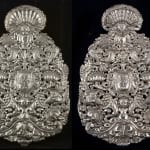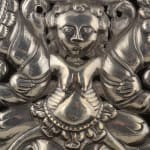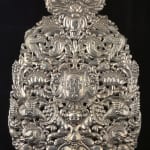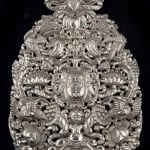Pair of Ornamental Plaques, 17th century
Silver; cast, worked, repoussé, chased and polished.
Further images
Provenance
Private Collection
Pair of oval-shaped ornamental plaques with undulating edges and decoration symmetrical with regard to a vertical axis. An oval-shaped medallion occupies the center of the composition, around which frenetic decoration is arranged in a horror vacui fashion. The upper area is crowned by a large scallop-shaped feature surrounded by a decorative border.
The central medallion is surrounded by scrolls and counter-scrolls that frame the Christogram JHS (Iesus Hominum Salvator), which has a cross over the horizontal of the H. This monogram was adopted by St. Ignatius Loyola (1491-1556) for the seal of superiors in the Company of Jesus, and thereby became the emblem of his institution. Under the monogram we find the three nails of the Passion. On the sides of the reserve, two large scrolls frame attractive sunflowers bursting with seeds, on which two fantastical birds are resting their claws, while with their long, half-open beaks, they try to pick at the bunches of grapes that are emerging out of the crown.
In the lower section, and on the same axis as the reserve with Jesus’ initials, we find a charming figure, an indigenous woman dressed in an overskirt made of leaves and feathers, with protruding ribs and sunken breasts, who carries a horn of plenty bursting with fruit in each arm, which rapacious and watchful birds are attempting to get at. The motif of the leaf-woman is a typical one, frequently occurring in Andean silverware, and which bears witness to the process of syncretism taking place in the Americas.
The decoration is of a naturalist variety, where floral motifs predominate, such as scrolls, phytomorphic elements, leaves and flowers rendered with fantastical imagination, a typical Andean plant called the maya, whose leaves were thought to resemble these sorts of ornamental plaques, leading to them being known as Mayas. We would highlight the skill and marked relief used in the depiction of the petals, leaves and fruits.
Of the rest of the ornamental motifs, it is worth highlighting the braided cords, decorative borders, little scrolls, and punch-marked surfaces over the entire piece, creating a sense of horror vacui framing and heightening the main features.
In addition, the undulating sides of the plaques are made up of forms representing birds, their feathers, bunches of grapes, flowers and horns of plenty, generating edges of powerful profiles and contrast.
The presence of the initials of Jesus in the cartouche and the bunches of grapes and varying fruits leads us to think that the iconographic program present in these plaques could be linked to a sacramental interpretation. The vine and its fruit are generally considered a symbol of Christ and his sacrifice, the presence of the grape is a reference to Christ’s Passion, a fitting subject for the installation of the plaques over a church altar to thereby reinforce the importance of the moment of the Eucharist, a key subject being promoted by the Counter-Reformation.
These ornamental plaques are the very finest examples of this kind of decorative object, where the silversmith has displayed his skills.









